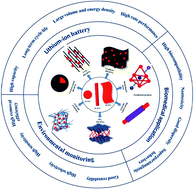Spinel ferrite (AFe2O4)-based heterostructured designs for lithium-ion battery, environmental monitoring, and biomedical applications
Abstract
The development of spinel ferrite nanomaterial (SFN)-based hybrid architectures has become more popular owing to the fascinating physicochemical properties of SFNs, such as their good electro-optical and catalytic properties, high chemothermal stability, ease of functionalization, and superparamagnetic behaviour. Furthermore, achieving the perfect combination of SFNs and different nanomaterials has promised to open up many unique synergistic effects and advantages. Inspired by the above-mentioned noteworthy properties, numerous and varied applications have been recently developed, such as energy storage in lithium-ion batteries, environmental pollutant monitoring, and, especially, biomedical applications. In this review, recent development efforts relating to SFN-based hybrid designs are described in detail and logically, classified according to 4 major hybrid structures: SFNs/carbonaceous nanomaterials; SFNs/metal–metal oxides; SFNs/MS2; and SFNs/other materials. The underlying advantages of the additional interactions and combinations of effects, compared to the standalone components, and the potential uses have been analyzed and assessed for each hybrid structure in relation to lithium-ion battery, environmental, and biomedical applications.

- This article is part of the themed collection: 2020 Reviews in RSC Advances


 Please wait while we load your content...
Please wait while we load your content...